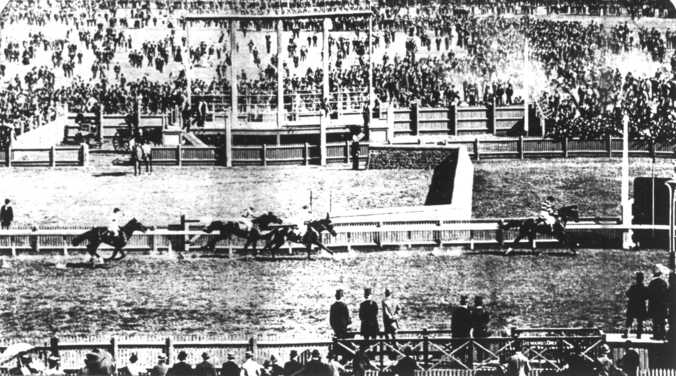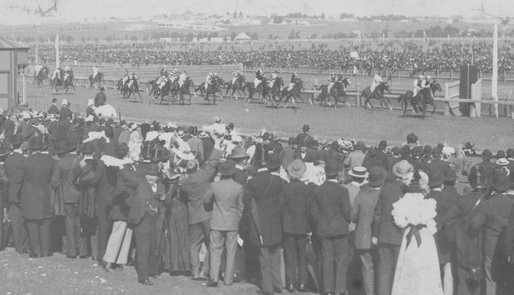The film of the Victoria Racing Club Derby of 1897

The finish of the 1897 VRC Derby at Flemington, Melbourne, Victoria1
Amongst the collection of earliest Australian films held by the
National Film and Sound Archive of Australia
is the one with title number 17281.
The NFSA has named this film [MELBOURNE CUP, 1897]
, and its summary states
that it is
Lumiere footage from the first Australian film featuring a camera pan shot. The finish of the Melbourne Cup race at Flemington Racecourse is shown. The horses and their jockeys return to the mounting area after the race.
The 1897 Melbourne Cup race was run on the afternoon of Tuesday, 2 November 1897 at Flemington racecourse, Melbourne, Victoria, Australia. The following day nearly all, or more likely all, daily newspapers in Australia published the results of the race, and in many cases an extended description of the race was given. A cursory glance at any of the major Australian papers, and in particular any published in Melbourne such as The Age or The Argus, will reveal two details about this Cup race: there were 29 runners, and the finish was very close.
But what is to be seen in the film in question? There are only 6 horses in the running, and the winner comes in several lengths in front.
Clearly, film number 17281 does not show the finish of the 1897 Melbourne Cup. So, what race finish is seen?
The film was taken at Flemington racecourse, as the winning post, judge's box, and weighing-in room as they were in that period are to be seen in the film.
The photograph1 above shows the horses at the end of the Victoria Racing Club Derby of 1897, which was held on the afternoon of Saturday, 30 October 1897 at Flemington racecourse. This image is a close match to that of the end of the race in the film. There were 6 horses in the Derby race, and the winner, Amberite, was 4 lengths ahead of Aurum, in second place. (The last two horses were to the left of the scene in the photograph.) Another detail in the film that matches that in this image is the striped jersey of the winning jockey.
The conclusion is that title no. 17281 is, in all probability, a film of the finish of the 1897 VRC Derby.
As for the NFSA's description, it is not clear exactly what Lumiere footage
means:
presumably it refers to film that was shot on a Lumière cinématographe,
or could be projected with one.
But title no. 17281 appears to be neither:
there is no sign on the edges of the film of the characteristic Lumière
single round perforations.
However, it is possible that the film was reframed when copied so any sign of
the single perf's on the edges of the frame images has gone.
One lost film has been found, but the price is another lost film.
Later note:
after initial disbelief, the NFSA have corrected the details for title number
172812, which they now call [V.R.C. DERBY RACE]
.
They have also clarified that it was filmed on stock with Lumière perforations.
This is how the 1897 Melbourne Cup finished:

The finish of the 1897 Melbourne Cup at Flemington, Melbourne, Victoria
Details of the film
There are 3 segments to the film: the last 10 or so seconds of the race; the horses return along the racetrack; and the winning horse and jockey proceed to the weighing-in room.
During the first segment, the camera is rotated horizontally in 2 brief jerks to follow the horses as they pass the winning post. (This is quite unlike the smooth pans we are used to now.) There are 6 runners, and we see all of them pass the post.
In the second segment, which is taken with the camera in the same location, pointing in the same direction, and with the same lens setting, the 6 runners appear from the right, cross the frame from right to left, turn around, and go back to the right. In the foreground, there is a movement of the crowd of people to the right.
The third segment appears to have been filmed from the same position, but with the camera now pointing towards the right of the previous scene, at the weighing-in room. Again, the crowd moves towards the right. The winning horse and rider go towards the weighing-in room, stop, and the jockey dismounts; the horse is begun to be led off when the film (abruptly) finishes.
The NFSA's 35 mm access copy (at least) of the film suffers from a slight difference in the vertical displacement of the image between alternate frames, so that when viewed at even a moderate frame-rate, the image is very jumpy. It appears that the camera used for filming (or printing) had a film advance mechanism that had 2 positions, and there was an error in the registration of these positions. If a digital copy were to be made of the film, this problem would be relatively easy to correct.
Thwaites and Harvie
Ernest Jardine Thwaites and Robert William Harvie made several films during the Melbourne spring racing season of 1897: of the Caulfield Cup, the VRC Derby, and the Melbourne Cup. Each film was celebrated at the time because it was shown on the evening of the day on which it was shot, i.e. about 6 hours later. It was also said that Thwaites made all the equipment – camera, film perforator, etc – used to produce these films.
A week following the 1897 Melbourne Cup race, Melbourne newspapers advertised a "pocket cinematographe" showing the "great race reproduced with marvellous realism". This was a flick-book (or flip-book or flickograph), with each photograph from the film reproduced on a separate page so that when the pages are flicked through, the illusion of motion results. They were available for sixpence from principal booksellers, or, though possibly from another manufacturer, at the London, American Supply Stores. The Melbourne Museum and the National Film and Sound Archive of Australia each has one of these in its collection; Thwaites and Harvie are stated, on the cover, to be the copyright holders. In October 2011 the NFSA made digital copies of the images in its copy, adjusted the registration, and made a very short video that simulates the effect of flicking through the book.
The blue ribbon film
After the VRC Derby it is traditional for the winning horse to have the "blue ribbon of the turf" placed around his neck. (It was also referred to as the "blue riband".) In the 1890s (at least) this was usually done by the wife of the Governor of Victoria. After the 1896 VRC Derby, Lady Brassey had performed this ceremony and was filmed doing so by Marius Sestier, but unfortunately no copy of this film is known to exist.
But a film of the 1897 ceremony does exist. According to film historian Chris Long, Albert James Perier had a 35 mm nitrate negative with Lumière perforations, probably the original, of this film, and in 1951 this was copied to an 8 mm version, which was in turn copied to 35 mm at the Australian Commonwealth Film Unit in the early 1960s. The film is included as part of The Pictures That Moved, a documentary made by the CFU in 1968. Perier said that he himself filmed the 1897 Melbourne Cup, and possibly he also filmed at the Derby, 3 days earlier.
Lord and Lady Brassey did not attend the activities at Flemington on Derby Day, 1897 because of the death during the previous week of the Duchess of Teck, a member of the British royal family. The investiture of the Derby winner, Amberite, on this occasion was performed by Mrs. Marie Freeman Thomas, the Brasseys' daughter and wife of Captain Freeman Thomas, one of the Governor's aides-de-camp. In the various published descriptions of the ladies' outfits on Derby day it was noted that Mrs. Freeman Thomas wore a black hat with black plumes, and such a hat is seen in the film. Also, Amberite had a lozenge-shaped blaze between his eyes, which is evident in the film. (In contradistinction, at the 1896 Derby ceremony, Lady Brassey wore a pale green toque, and Newhaven, the 1896 winner, had a blaze the length of his nose.)
References and notes
[1] 6 November 1897, The Australasian (Melbourne, Victoria), p.1004, Finish for the Derby (detail).
[2] Their curators would have one think that they initiated the research
that led to the correct identification of the film.
On page 124 of the NFSA's Annual Report 2011-12,
in the article "Flicking Through Racing History", they state:
However, careful study of the footage revealed that it was not actually
showing Australia’s biggest race.
According to a count of finishing horses from that year, the curators
determined that the footage was, in fact, the 1897 Victoria Racing Club Derby.
[sic]
But all they did was confirm what I told them, on 10 June 2011, about the misidentification of the film:
This film is of the finish of the 1897 Victoria Racing Club Derby race, *not* the Melbourne Cup. This can easily be confirmed by reading contemporary newspapers. Salient points are: there were only 6 runners in the Derby, and all finished; the winning horse in the Derby was 4 lengths in front, whereas the finish of the Melbourne Cup was very close – less than a head; the winning jockey of the Derby wore a striped jersey.The NFSA's reply of 16 June was:
On advice from our curatorial officer responsible for these films, no changes will be made at present to the information regarding this film, Her opinion on the matter is that we have no definitive answer at this stage and so for now we will leave it as is, on the basis that this is the information given to us at the time of acquisition. When time permits it will be investigated thoroughly, taking into account all known information about it.
"Credit were credit is due" should be an article of the NFSA's Service Charter.
|
Copyright © 2011 – 2013 Tony Martin-Jones | FILM HISTORY INDEX |
Edition 3·3 (2013-11-24) [First edition in 2011-06] |